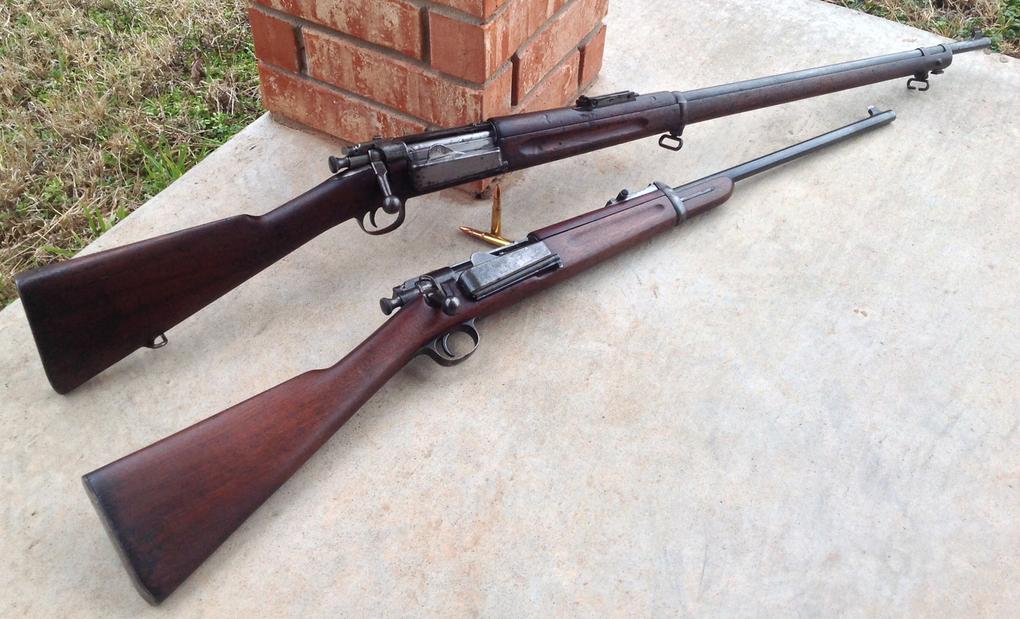





Krag-Jorgensen .30-40 Krag rifle and cavalry carbine


| Type | Rifle |
|---|---|
| Place of origin | United States |
| Service history | |
| In service | Army |
| Used by | United States |
| Production history | |
| Designed | 1892 |
| Specifications | |
| Case type | Rimmed, bottleneck |
| Bullet diameter | .308 in (7.8 mm) |
| Neck diameter | .338 in (8.6 mm) |
| Shoulder diameter | .423 in (10.7 mm) |
| Base diameter | .457 in (11.6 mm) |
| Rim diameter | .545 in (13.8 mm) |
| Rim thickness | .064 in (1.6 mm) |
| Case length | 2.314 in (58.8 mm) |
| Overall length | 3.089 in (78.5 mm) |
| Case capacity | 58.0 gr H2O (3.76 cm3) |
| Maximum pressure (C.I.P.) | 47,137 psi (325.00 MPa) |
| Maximum pressure (SAAMI) | not established |
| Maximum CUP | 40,000 CUP |
The .30-40 Krag (also called .30 U.S., or .30 Army) was a cartridge developed in the early 1890s to provide the U.S. armed forces with a smokeless powder cartridge suited for use with modern small-bore repeating rifles to be selected in the 1892 small arm trials.
Since the cartridge it was replacing was the .45-70 Government, the round was considered small-bore at the time.
The design selected was ultimately the Krag–Jørgensen, formally adopted as the M1892 Springfield. It was also used in M1893 and later Gatling guns.
Contents
History and development[edit]
Though the U.S. Navy and Marine Corps had adopted limited numbers of smokeless powder, bolt-action rifles, the .30-40 was the first cartridge adopted by the US Army that was designed from the outset for smokeless powder.
After a brief experiment with a 230-grain bullet loading, the .30 Army loading was standardized in 1894 using a 220-grain metal-jacketed round-nose bullet with 40 grains of nitrocellulose powder.
This loading developed a maximum velocity of 2,000 ft/s (610 m/s) in the 30-inch (760 mm) barrel of the Krag rifle,[2]and 1,960 ft/s (600 m/s) in the 22-inch (560 mm) barrel of the Krag carbine.
The rimmed .30-40 round was also known as .30 Army, or .30 U.S. Although the .30-40 Krag was the first smokeless powder round adopted by the U.S. military.
It retained the “caliber-charge” naming system of earlier black powder cartridges, i.e. a .30-caliber bullet propelled by 40 grains (2.6 g) of smokeless powder.
The first use of a smokeless powder round by Winchester was a single shot in 30-40, and it was one of only three rounds chambered for the 1895 Winchester lever action, introduced in 1896.[3]
From the outset, the .30-40 cartridge proved popular for hunting, and was chambered in a variety of firearms.
In 1899, a Krag in .30-40 caliber was used to shoot the world-record Rocky Mountain elk. The record stood until the latter half of the 20th century.
In October 1899, after reviewing the experiences of the Spanish–American War.
U.S. Army ordnance authorities developed a new loading for the .30 Army used in the Krag rifle, in an attempt to match the ballistics of the 7×57mm Mauser cartridge employed by Spanish forces in that conflict.
The new loading increased the muzzle velocity in the rifle version of the Krag to 2,200 ft/s (670 m/s) at 45,000 psi.
However, once the new loading was issued, reports of cracked locking lugs on service Krags began to surface.
In March 1900 the remaining stocks of this ammunition (some 3.5 million rounds) were returned to the arsenals, broken down, and reloaded back to the original 2,000 ft/s (610 m/s) specification.
In 1903, after recommendations from the infantry Small Arms Board, the U.S. Army formally adopted a higher-velocity .30-caliber replacement for the .30-40 or .30 Army cartridge.
The new cartridge was designated by its year of adoption, the
A replica of the McKeever-pattern .30 US Army cartridge case.
